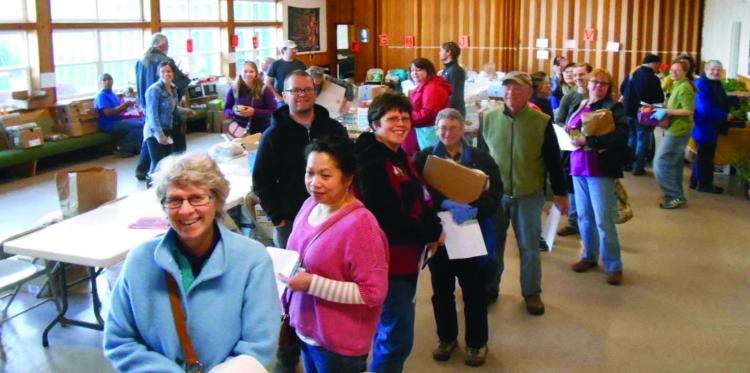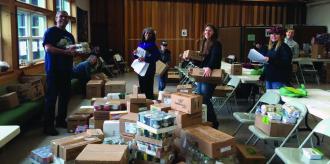Hybrid Startup Serves Island Community



Introduction: Outside the Mold
by Stuart Reid, Food Co-op Initiative
Among the hundreds of communities starting new food co-ops, there are always those who don’t fit the mold—some because they have unique visions, some because they have unique situations. Either of these can make it difficult to find the right solutions to becoming successful, sustainable food co-ops.
Consequently, when we at Food Co-op Initiative see an unusual startup that appears to be flourishing in the face of myriad obstacles, we take note. The Sitka Food Co-op is just such an effort: very little local production (aside from seafood!), no roads leading to another community, with existing grocery store competition and a population of only 8,900—but with sales exceeding $250,000 and growing by 30 percent or more…
How do they do it? Dynamic leadership, commitment from the community, and a clear focus on meeting the unmet needs of their community. Here is their story so far.
Hybrid Startup Serves Island Community
The Sitka Food Co-op began as a result of the need to bring healthy, organic foods to Sitka at more affordable prices than were available to its community. The co-op’s motto: “Bringing Good Food & Community Together.”
Sitka is an isolated island community of some 9,000 individuals, situated on the outer coast of Alaska’s Southeast “panhandle.” There are no roads into or out of town, nor are there any other communities connected to theirs—except by air or water. The nearest town of any size is 90 miles away by air or 140 miles by ship. Needless to say, the acquisition of any type of product is considerably more expensive than in most regions of the United States.
Thus, unlike many food cooperatives, Sitka Food Co-op doesn’t have a large population base, it isn’t located near a major university, and it has no adjacent communities to depend upon for additional sales and support. Of Sitka’s 9,000 residents, 32 percent are Alaska Native, American Indian, or from another minority; and 17 percent of the population participates in the food stamp program. Between 2003 and 2011, food costs rose 43.6 percent. Food costs are also 57 percent higher than in Portland, Ore., and 37 percent higher than in Anchorage, which is almost 600 miles to the northwest.
Given all this, the co-op has had to create an alternative model for developing a cooperative program that is viable for a small, rural, and isolated community that has definite financial constraints. Since its inception in 2011, Sitka Food Co-op has grown from a few families that joined together to form a buying club to an incorporated food cooperative that is now serving over 200 households. Its sales/purchases were just under $200,000 for the 2015 calendar year. Sales for 2016 are projected to reach over $260,000, a 30 percent growth rate.
But…we don’t even have a storefront yet!
Whatever it is, it’s working
Some people have described this nascent co-op that pops up twice a month as a “buying club on steroids.” Others see it as a hybrid, an organization in transition, operating as both buying club and a cooperative. What can be said about us is that we are successfully meeting the needs of a growing percentage of our community—and doing so profitably.
Currently, the co-op rents a 2,400-square-foot space in a community hall where preordered goods are delivered to the members. Along with that, with each delivery, several thousand dollars of retail goods are also set out for both members and the general public to purchase.
The co-op’s goal has always been to operate a storefront open to our general community while continuing to offer the option for members to preorder items at case-lot and bulk prices.
What we’re trying to do…and are doing…is following a more traditional, old-school model of cooperative development. Where people come together to solve a problem and fill a need in their local community (pardon the pun) organically. Given the constraints of our demographics, we just can’t raise two or three or more million dollars in capital to open a storefront that is on the same scale as a major retailer. What we can do, however, is slowly grow to the point where we can! With each and every month of our operation, we are not only serving the needs of our community, but we are also building capital to make our dream come true.
As the co-op has grown, we’ve been able to build capital reserves, purchase needed equipment, hire employees (at a living wage), and even invest some of our savings with Shared Capital Cooperative—supporting a cooperative that supports cooperatives!
A store in 2017?
Our timeline has always been to get “doors on a store” in 2017—six years after forming—and we are well on our way to achieving that goal. Not to say we haven’t had our share of growing pains, but we have also taken pains to ensure that, as we grow, proper governance is in place, policies and protocols established, and our vision maintained.
Of course, we haven’t done this all on our own. Without the help, guidance, and consultations provided by both state and national organizations—such as the Alaska Cooperative Development Center, Food Co-op Initiative, the Howard Bowers Fund, and the Ralph K. Morris Foundation—I strongly believe we wouldn’t be as successful as we are now. Being able to attend conferences across the country—such as CCMA and Up & Coming—has also benefitted us tremendously.
While all cooperatives are unique—each with its own set of circumstances to deal with—the Sitka Food Co-op, in working to meet the needs of its community, has the potential to set an example for other small and isolated communities throughout the country that face similar demographic and economic situations—whether they be in Alaska, the hills of Appalachia, the rural Midwest, or the mountains of the West.







